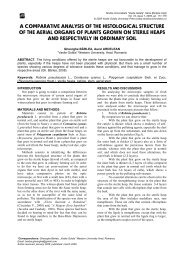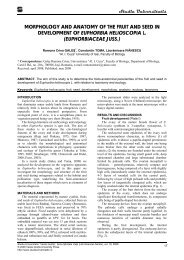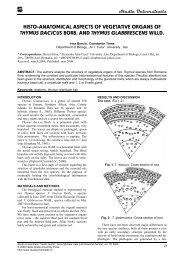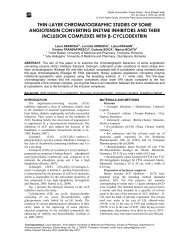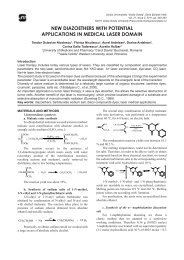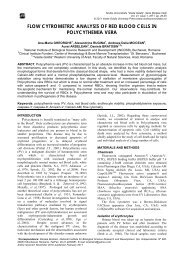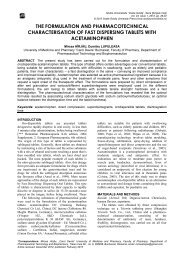Lacrajnan - Varghese - Studia Universitatis Vasile Goldis, Seria ...
Lacrajnan - Varghese - Studia Universitatis Vasile Goldis, Seria ...
Lacrajnan - Varghese - Studia Universitatis Vasile Goldis, Seria ...
You also want an ePaper? Increase the reach of your titles
YUMPU automatically turns print PDFs into web optimized ePapers that Google loves.
Integration of artificial neural networks<br />
into an lindenmayer system based plant<br />
modeling environment with mathematica<br />
Individual processing elements receive inputs from<br />
many other processing elements (x i) via weighted<br />
connections. We can get the dimensions of the input and<br />
output vectors from the architecture artificial neural<br />
networks , the input is the first element, the desired output<br />
is the second element. We can set the size of the artificial<br />
neural networks.<br />
In this figure 5, every processing element receives<br />
one or more inputs (x i) via weighted connections (α hidden).<br />
The initial set up in this research, the artificial neural<br />
network requires 2-element input (organic fertilizer and<br />
inorganic fertilizers), 3 hidden elements and a single<br />
output (that's called stalk). From the 3 elements hidden<br />
layer, it will be obtained the weights of the inputs to the<br />
hidden layer and the weights of the hidden layer to the<br />
output layer.<br />
These weighted inputs (αhidden.<br />
x i) are summed and the<br />
threshold value (θ j) is then added, generating a single<br />
activation level for the processing element (h hidden).<br />
hhidden<br />
= ĺ a<br />
hiddenixi<br />
+ q<br />
j<br />
This activation level constitutes the argument of a<br />
transfer function , sigmoid function as in Listing 7. This<br />
function then generates the node output . This output is<br />
passed to the weighted input connections of many other<br />
processing elements. This process is shown for node j in<br />
Figure 4.<br />
Fig. 4 Operation of a typical processing element.<br />
The Back-propagation networks is the network type propagation method, and Training Set function within<br />
most suited to forecasting (Niklas, 1986). The expected Mathematica is used (Freeman, 1994). The high level<br />
relation is “learned” by repeatedly presenting samples of code to run the overall 'artificial neural network' system<br />
the expected input/output relationship to the network and that is already developed, is shown in Listing 1. In this<br />
adjusting the model parameters (i.e. the connection code, it runs with 12500 at organic fertilizer 0 and<br />
weights) in order to get the best possible match between inorganic fertilizer 50. For the first 12500 of running this<br />
the historical values and those generated by the model. code, the epoch size is plotted as seen in Figure 5. The test<br />
To present the training set of input (organic fertilizer result of the program is shown in Listing 2.<br />
and inorganic fertilizers) and stalk output using the back<br />
List. 1 The code of running it through our network with 12500 at organic fertilizer 0 and inorganic fertilizer 50<br />
<strong>Studia</strong> <strong>Universitatis</strong> “<strong>Vasile</strong> Goldiş”, <strong>Seria</strong> Ştiinţele Vieţii<br />
Vol. 22, issue 3, 2012, pp. 411-418<br />
© 2012 <strong>Vasile</strong> <strong>Goldis</strong> University Press (www.studiauniversitatis.ro)<br />
415



